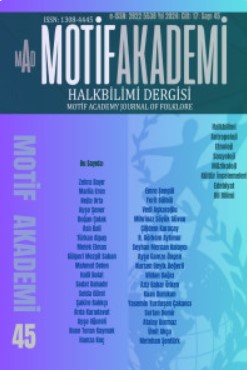BİR DEVİR ÜSLUBUNUN BİR BÖLGE KARAKTERİNE DÖNÜŞÜ: ÇIKRIK CAMİİ KALEM İŞİ SÜSLEMELERİ
FROM THE STYLE OF AN ERA TO THE CHARACTER OF A REGION: ÇIKRIK MOSQUE HAND-DRAWN DECORATIONS
Author(s): Çiğdem KaraçaySubject(s): Cultural history, Architecture, Visual Arts, Islam studies
Published by: Motif Halk Oyunları Eğitim ve Öğretim Vakfı
Keywords: Mecitözü; Çıkrık Village Mosque; hand-drawn work; embroidery; decoration;
Summary/Abstract: Çıkrık Village is located in the central district of Çorum. Çıkrık Mosque is located in the village center. There is no construction inscription of the mosque. The document regarding the appointment of the imam dated 1843 in the foundation records archive shows that the mosque existed in the first half of the 19th century. The date 1904 is read on the sign on the entrance door of the mosque. This date must belong to a radical repair that the mosque underwent. The repairs carried out in the mosque are aimed at the functionality of the mosque. When you enter the harim, it becomes clear that the mosque attaches importance to aesthetic values as well as functionality. The hand-drawn embroidery in the harim, consisting of floral motifs and text dominated by turquoise color, is of recent date. These embroideries are important because they show the transformation of the tradition of an era into the character of a region, rather than artistic creation. The aim of this study is to examine the tradition of hand-drawn embroidery, which has been decorating mosques in Çorum for centuries, in the context of Çıkrık Mosque. In the study, first of all, the architectural and ornamental features of Çıkrık Mosque were introduced and documented. Then, Çorum was included because it is the keystone of the tradition that spread from the city center to the districts and villages. Çıkrık Village was a village affiliated with Mecitözü until the 1990s. For this reason, the mosques identified in Mecitözü and its villages are included in this study. It is possible to say that decorating mosques with hand-drawn embroideries in the mentioned regions has been seen as a period style since the 18th century, and today it has turned into a cultural practice with a traditional aesthetic understanding.
Journal: Motif Akademi Halkbilimi Dergisi
- Issue Year: 17/2024
- Issue No: 45
- Page Range: 275-290
- Page Count: 16
- Language: Turkish

